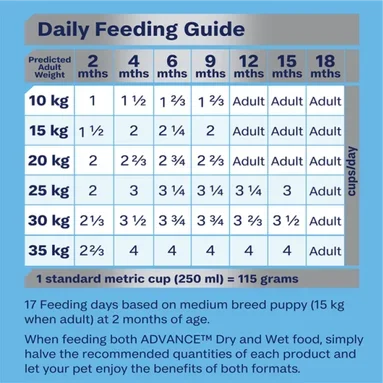Puppy diets are specifically formulated with a higher concentration of protein, fat, and energy than 'adult dog' varieties, to support rapid growth. They also have higher levels of calcium and phosphorus, although these nutrients are lower for large breed pups to reduce the risk of skeletal abnormalities.
1. Energy needs are greater for puppies, as they are growing every day. This means that calorie content is higher in puppy food. The optimal calorie content for your puppy varies based on breed, size, and activity level - for instance, large breed puppy food contains a lower calorie content than small breed puppy food to ensure a slower, steadier growth rate that allows their larger bones to develop properly.
2. Protein is also higher in puppy food. A puppy's need for protein is highest immediately after weaning, and decreases slowly after this. AAFCO recommends puppy food contain a minimum of 22.5% crude protein on a dry matter basis, or 56.3 grams per 1000kcal, whereas adult dogs only require a minimum of 18% on a dry matter basis, or 45 grams per 1000kcal.1
3. Fat is also higher in puppy food than adult food. Fat is a source of essential fatty acids and is a concentrated source of energy, although too much can lead to obesity and developmental orthopaedic disease. AAFCO recommends puppy food contain a minimum of 8.5% crude fat on a dry matter basis, or 21.3 grams per 1000kcal, whereas adult dogs only require a minimum of 5.5% on a dry matter basis, or 13.8 grams per 1000kcal. Puppies also have a higher requirement of certain fatty acids, such as linoleic acid, EPA and DHA. 1
4. Vitamin & Mineral requirements are different for puppies compared to adults. Calcium and phosphorus are particularly important, and required in higher quantities than adults. However the need for these nutrients differs greatly between large and small breed puppies. Large breed puppies are extremely sensitive to over-feeding calcium and can develop skeletal abnormalities if this occurs. Thus, AAFCO has established a 'minimum' calcium level of 1.2% on a dry matter basis for puppies and 0.5% for adults, as well as a 'maximum' level - large breed puppy food should not exceed 1.8% calcium, whereas small and medium breed puppy food should not exceed 2.5%.
You're probably thinking that calculating exactly how much of each nutrient your puppy needs sounds rather complicated. The good news is, with commercial pet food, the hard work has already been done for you. Every pet diet comes with feeding guidelines printed on the packaging. Read more about this below.











